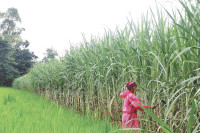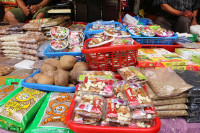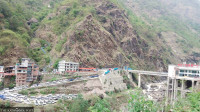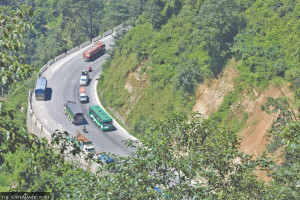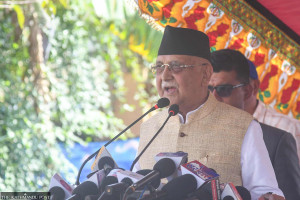Money
Floods, airport upgrade cut GDP growth by 1 percent
The World Bank has warned that Nepal’s placement on the FATF Grey List could harm its international transactions and financial reputation.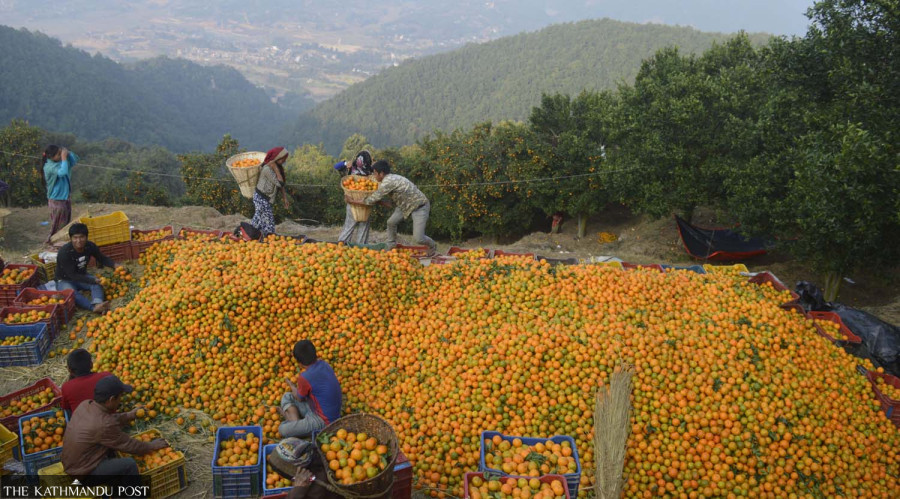
Sangam Prasain
Floods and landslides in late September, followed by infrastructure upgrade at Nepal’s key international airport, caused a significant dent in the country’s economic growth, according to the World Bank report released on Thursday.
The two events may have shaved off nearly 1 percent of the country’s GDP.
The Nepal Development Update, produced twice a year, stated that the floods and landslides in September last year caused damage equivalent to 0.8 percent of GDP. The September 26-28 floods were a devastating consequence of unusually intense monsoon rains, exacerbated by climate-related changes.
Overall damage is estimated at Rs46.7 billion, spanning infrastructure, agriculture, and social sectors, underscoring the need for urgent recovery and reconstruction efforts.
The floods inflicted extensive damage across key sectors. Infrastructure losses amounted to Rs38.9 billion, including roads (Rs28 billion), hydropower facilities (Rs3 billion), telecommunications (Rs152.3 million), water supply and sanitation systems (Rs5.9 billion), and bridges (Rs1 billion).
The agricultural sector suffered Rs7.2 billion in losses, with vast farmlands submerged, crops destroyed, and heavy livestock casualties. The education and health sectors also faced significant disruptions, with damages totalling Rs91.9 million due to affected schools and health facilities.
Furthermore, the upgrade of Tribhuvan International Airport, initiated in November 2024, led to significant disruptions in the tourism sector. Reduced operating hours and higher ticket prices—exacerbated by the absence of an alternative international airport—impacted travel.
The project, initiated on November 8, 2024, was completed by March 31, 2025. Despite strategic phasing, the upgrade disrupted TIA’s operations, resulting in flight delays, cancellations, and a 30–35 percent reduction in domestic flights. Consequently, tourist arrivals declined in the second quarter of the current fiscal year.
Travel trade entrepreneurs and economists had criticised the airport upgrade in the key tourism season as a deliberate “restriction,” especially when alternatives were available to minimise disruption.
The report noted that service exports declined slightly by 0.1 percentage points to 1.9 percent of GDP in the first half of the current fiscal year, largely due to reduced travel and transport services. This reflected a slowdown in the growth of tourist arrivals.
With this, Nepal’s economy is expected to grow by 4.9 percent in the first half of the current fiscal year, up from 4.3 percent in the same period last fiscal year, primarily due to a pickup in agricultural and industrial sector growth.
However, a slowdown in the services sector partially offset these gains.
For the full fiscal year, Nepal’s economy is projected to grow by 4.5 percent, up from 3.9 percent in the last fiscal year.
The World Bank has flagged the risk of Nepal being placed on the Grey List by the Financial Action Task Force (FATF). The report indicated that the consequences of being on the Grey List could be significant and include restricted cross-border transactions, potentially reducing official remittance inflows, reduced foreign investment due to heightened perceived risks, and higher transaction costs for financial institutions facing increased scrutiny from regulators.
Additionally, Grey List placement damages international reputation, impacting tourism and trade partnerships. As a result, this hampers Nepal’s recent efforts to access global capital markets. However, the report also noted that this could serve as an opportunity for Nepal to implement critical reforms to support the country’s financial sector and boost economic growth.
Nepal has two years to implement necessary reforms, and authorities have committed to meeting the deadline.
Nepal was placed on Grey List on February 21, due to concerns over weaknesses in its financial system, including ineffective regulatory enforcement and insufficient implementation of anti-money laundering and combating the financing of terrorism (AML/CFT) policies.
While the government has committed to take corrective measures, practical implementation remains a challenge. Of the 40 key recommendations of the FATF, Nepal has so far fulfilled only 21. This marks the third time Nepal has been placed on the Grey List, following similar listings in 2008 and 2014.
The report projects Nepal’s industrial sector would grow in the medium term, primarily fueled by significant expansion in the electricity and construction sectors. The 140-megawatt Tanahun Hydropower Project, Nepal’s third storage-type project, is expected to be completed by the next fiscal year 2025-26.
The government’s 16th development plan aims to increase installed capacity of electricity from the existing 3,402 MW to over 11,700MW by 2028-29. The Energy Development Roadmap also aims to export 4,000 MW from the existing 941MW, which is expected to support industrial growth.
The World Bank has called for significant investment in transmission and distribution infrastructure, alongside measures to stimulate domestic electricity demand.
Furthermore, a series of policy measures aimed at supporting the construction sector—such as loan repayment extensions, moratoriums on blacklisting, relaxed credit rating requirements, and Nepal’s prioritisation of clearing outstanding payments to contractors—are likely to stimulate activity from the next fiscal year.
Risks to Nepal’s economic growth outlook remain tilted to the downside. Externally, geopolitical uncertainties and the escalating trend of trade-restrictive measures pose a serious threat. These global factors could trigger renewed and sharp surges in international commodity prices, particularly for essential goods like fuel and food.
Such price shocks would exert widespread pressure across all sectors of the Nepali economy, fueling inflation, increasing production costs, and dampening consumer demand. Since Nepal’s growth model relies heavily on remittances and tourism, a slowdown in partner countries could lead to a decline in both, further hindering economic growth.
The World Bank noted that a decline in the health of Nepali financial institutions could lead to a tightening of private sector credit, restricting access to capital for businesses and individuals, thereby hindering investment and economic activity.
Additionally, frequent bureaucratic reshuffles at the government level risk policy inconsistency and create an environment of uncertainty, severely undermining investor confidence and deterring domestic and foreign investment, the report warns.
David Sislen, World Bank Country Division Director for Maldives, Nepal, and Sri Lanka, emphasised that boosting private sector-led economic growth is critical to creating the jobs Nepal needs.
He stated that Nepal can build on its impressive track record of resilient growth by implementing key structural reforms.
Shiva Raj Adhikari, vice chairman of the National Planning Commission, added that the Nepal Development Update provides valuable insights on recent economic developments and highlights Nepal’s resilient growth. He, however, stressed that meeting the country’s 16th Plan targets will require effective execution of the capital budget and timely completion of ongoing projects.
On the positive side, Nepal’s economy may benefit from the private sector-led growth reforms introduced through five ordinances passed by Parliament earlier this week.




 23.12°C Kathmandu
23.12°C Kathmandu
